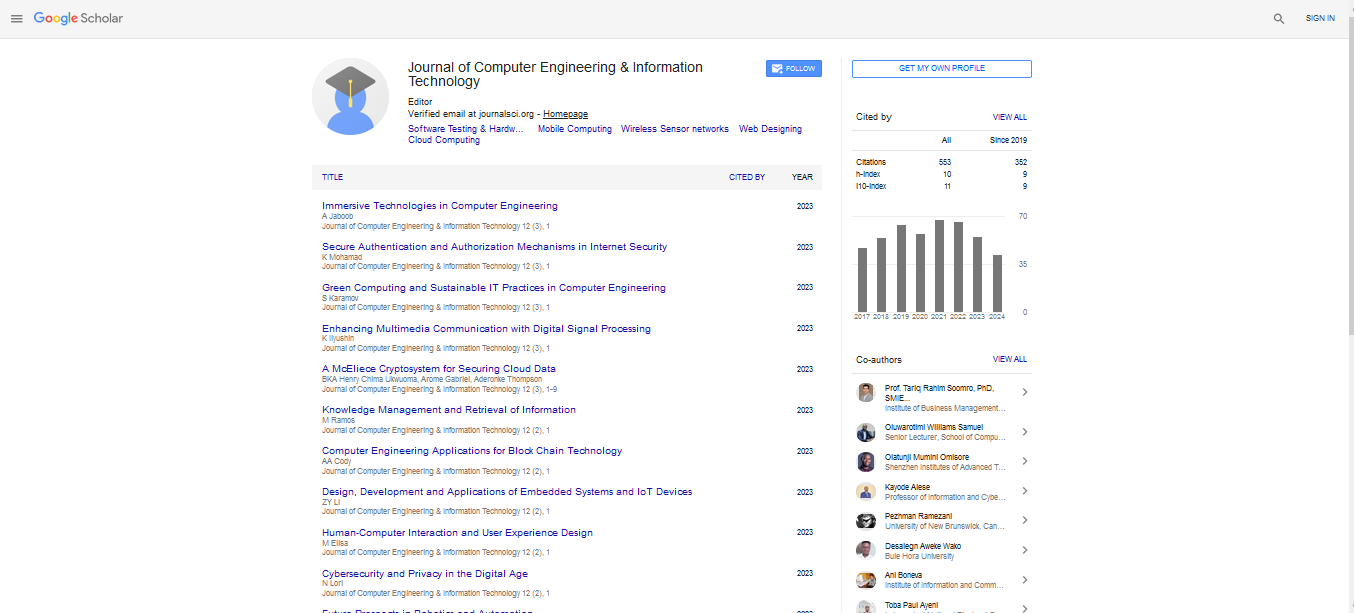Editorial, Jceit Vol: 14 Issue: 2
Microprocessors: The Heart of Modern Computing
Carolina Sophia*
Department of Mathematical Stochastics, University of Freiburg, Germany
- *Corresponding Author:
- Carolina Sophia
Department of Mathematical Stochastics, University of Freiburg, Germany
E-mail: Carolina@soph.de
Received: 01-March-2025, Manuscript No jceit-25-169317; Editor assigned: 4-March-2025, Pre-QC No. jceit-25-169317 (PQ); Reviewed: 20-March-2025, QC No jceit-25-169317; Revised: 27-March-2025, Manuscript No. jceit-25-169317 (R); Published: 31-March-2025, DOI: 10.4172/2324-9307.1000339
Citation: Carolina S (2025) Microprocessors: The Heart of Modern Computing. J Comput Eng Inf Technol 14: 339
Introduction
Microprocessors are the fundamental building blocks of modern digital technology. Often referred to as the “brain” of a computer or an embedded system, a microprocessor is an integrated circuit (IC) designed to perform computational tasks by executing instructions stored in memory. Since their inception in the early 1970s, microprocessors have revolutionized the way we interact with technology [1], enabling everything from personal computers and smartphones to complex industrial automation and artificial intelligence systems.
What is a Microprocessor?
A microprocessor is a single-chip central processing unit (CPU) that performs arithmetic, logic, control, and input/output (I/O) operations based on programmed instructions. Unlike earlier computing devices that used multiple components, the microprocessor integrates all CPU functions into one chip, dramatically reducing size, cost, and power consumption [2].
The main components of a microprocessor include:
- Arithmetic Logic Unit (ALU): Performs mathematical and logical operations.
- Control Unit (CU): Directs the operation of the processor by interpreting instructions.
- Registers: Small storage locations for temporary data.
- Bus Interface: Manages data flow between the processor and other hardware components.
Evolution of Microprocessors
The journey began with Intel’s 4004 in 1971, the world’s first commercially available microprocessor. This 4-bit processor was designed for calculators but laid the groundwork for future development. The introduction of 8-bit (e.g., Intel 8080), 16-bit (e.g., Intel 8086), and later 32-bit and 64-bit microprocessors enabled more complex and powerful computing [3].
Over the decades, advances in semiconductor technology, such as reduced transistor size (Moore’s Law), have allowed microprocessors to become faster, more efficient, and capable of integrating billions of transistors on a single chip. Modern microprocessors feature multi-core designs, allowing parallel processing to enhance performance.
Applications of Microprocessors
Microprocessors are ubiquitous in everyday life, driving a wide array of applications:
- Personal Computing: PCs, laptops, and tablets.
- Mobile Devices: Smartphones and wearable technology.
- Embedded Systems: Automotive controls, household appliances, and medical devices.
- Industrial Automation: Robotics, control systems, and IoT devices.
- Gaming Consoles: High-performance graphics and processing.
- Communication Systems: Routers, switches, and base stations.
Challenges and Future Trends
Despite tremendous progress, microprocessor design faces challenges such as heat dissipation, power consumption [4], and physical limits of silicon-based technology. Innovations like quantum computing, neuromorphic processors, and photonic chips are being explored as future alternatives.
Additionally, the rise of artificial intelligence and machine learning workloads is driving the development of specialized processors (e.g., GPUs, TPUs) optimized for parallel data processing [5].
Conclusion
Microprocessors have fundamentally transformed technology and society by enabling compact, powerful, and affordable computing devices. Their continued evolution fuels innovation across countless fields, making them indispensable to modern life. As research pushes the boundaries of processing power and efficiency, microprocessors will remain central to technological advancement well into the future.
References
- Forrester Research. (2023). The Forrester Wave: Low-Code Development Platforms.
- Gartner. (2024). Market Guide for Low-Code Application Platforms.
- Mendix. (2023). What is Low-Code?
- OutSystems. (2023). No-Code vs Low-Code: Understanding the Differences.
- TechRepublic. (2023). The benefits and challenges of low-code/no-code platforms.
Indexed at, Google Scholar, Crossref
Indexed at, Google Scholar, Crossref
Indexed at, Google Scholar, Crossref
Indexed at, Google Scholar, Crossref
 Spanish
Spanish  Chinese
Chinese  Russian
Russian  German
German  French
French  Japanese
Japanese  Portuguese
Portuguese  Hindi
Hindi 